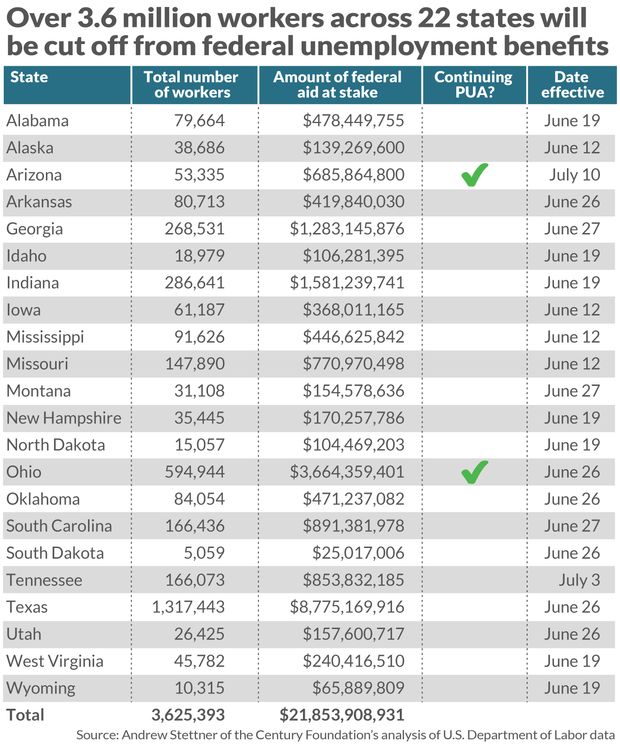More than 3.6 million Americans across 22 Republican-led states will soon be cut off from enhanced federal unemployment benefits that have prevented many people from slipping into poverty during the pandemic.
These states’ governors say these benefits, which were scheduled to expire in September, are overly generous and are contributing to mounting complaints they hear from employers who cannot fill job vacancies. The benefits include an extra $300 per week for all jobless Americans.
“It has become clear to me that we cannot have a full economic recovery until we get the thousands of available jobs in our state filled,” Gov. Tate Reeves, a Republican from Mississippi, said last week on Twitter.
“ ‘Time is what jobless workers need as the economy revs back up.’ ”
Reeves and the other governors point to the U.S. adding some 266,000 jobs in April — far below the 1 million jobs economists were forecasting. Meanwhile, there are more than 8 million unfilled positions in the U.S., according to the Department of Labor’s Job Openings and Labor Turnover Survey.
Texas Gov. Greg Abbott noted that “the number of job openings in Texas is almost identical to the number of Texans who are receiving unemployment benefits,” in a statement published Monday.
Some 1.3 million Texans will be losing federal pandemic unemployment benefits, which accounts for more than one-third of the 3.6 million Americans overall who will see their benefits end as states pull the plug, according to one analysis published by Andrew Stettner, an unemployment expert at the Century Foundation, a liberal-leaning think-tank.
Other elected officials say generous unemployment benefits aren’t keeping Americans at home —- low wages are. “Let’s be clear. There is not a shortage of willing workers in America,” Sen. Bernie Sanders, the former Democratic presidential candidate and Independent senator from Vermont, said in a statement last week.
“There is a shortage of employers willing to pay workers a living wage with decent benefits. If employers truly want to expand their workforce, there is a simple solution: raise wages and provide decent benefits,” he added.
Some labor experts are skeptical that ending federal unemployment benefit programs will spark an outpouring of job applications for two main reasons — many workers still need to care for a child or elderly person and/or they’re afraid of getting coronavirus on the job.
Here is a list of those states that are ending the benefits, and when:

How much money is at stake?
The jobless workers in question could lose approximately $230 per week in Pandemic Assistance Unemployment (PUA) benefits, which enabled gig workers, independent contractors and self-employed workers to collect unemployment benefits they would otherwise be ineligible for, and the $300 add-on weekly benefit.
That’s according to calculations the Department of Labor’s Employment and Training Administration provided MarketWatch, based on the national average weekly benefit amount during the first quarter of 2021
With the exception of Arizona and Ohio, most states are ending the PUA program. More than 7 million Americans received PUA benefits as of April 24, according to the DOL.
“ ‘Let’s be clear. There is not a shortage of willing workers in America.’ ”
On top of that, most governors are also ending federal programs that enabled people to collect unemployment who have already exhausted their state benefits. and one that allowed people with multiple sources of income — including self-employed workers — to collect an additional $100 a week.
People who relied on the extended benefits program will lose $606 a week, including the $300 add-on benefit if their state terminates it, according to DOL calculations based on the national average weekly benefit amount during the first quarter of 2021.
Some states, including Arizona, Montana and Ohio, are offering return-to-work bonuses as high as $2,000 to further incentivize workers to get reemployed.
In addition to a bonus, Arizona is providing funds to cover three month’s worth of child-care costs to individuals who return to work and earn less than $25 an hour at their new job.
Cutting workers off from federal unemployment benefits is “a tragedy,” said Stettner.
“Time is what jobless workers need as the economy revs back up, but it’s exactly what these [22] governors are now taking away from them by cutting off pandemic benefits,” Stettner said.



